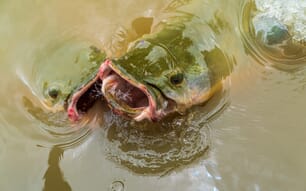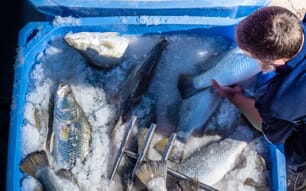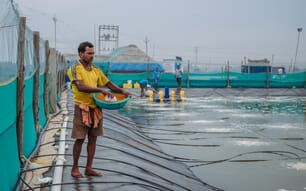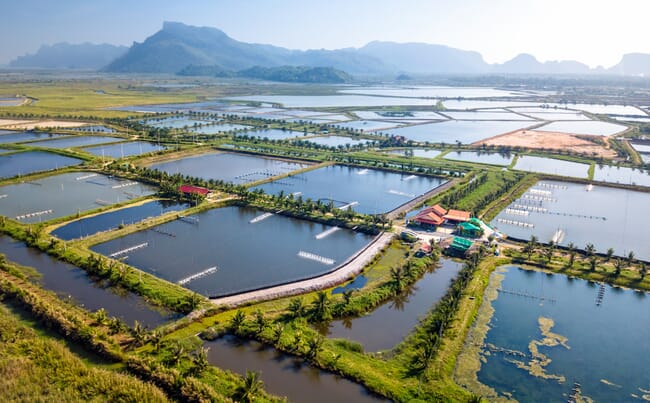
In shrimp farming, nitrite has been shown to depress immune function and increase oxidative damage in animals, making them more susceptible to many pathogens © Shutterstock
Most finfish and shrimp producers are continuously adding nitrogen to their ponds and tanks through regular feeding. A large proportion of these nitrogen inputs enters the water as waste in the form of ammonia. Ammonia, of course, is toxic to many aquatic species at low concentrations, but just how low depends to some extent on temperature, pH and the species being cultured. Ammonia is produced as a by-product of protein catabolism, so as a general rule higher protein levels in feeds usually result in higher ammonia production.
In natural aquatic environments, ammonia is typically broken down by two distinct groups of nitrifying bacteria. In both freshwater and marine environments, one of these groups converts ammonia into nitrite, which is also toxic to fish and invertebrates, while the other group converts nitrite into nitrate, which is relatively non-toxic. In recent years a number of other nitrifying bacteria isolated from shrimp farming facilities, some with surprising taxonomic designations, have demonstrated the ability to remove both ammonia and nitrite in brackish and saline environments. In fact, modern molecular methods have demonstrated that many bacteria are genetically equipped for nitrification (oxidation of ammonia and/or nitrite), denitrification (reduction of nitrate to nitrogen) or some combination of these activities (Prena et al. 2021).
In freshwater fish and most decapods, nitrite primarily enters from the surrounding environment across the gills, while in saltwater fish it is mainly absorbed across the intestinal lining. A major concern with high nitrite levels in finfish production is referred to as methemoglobinemia, or brown blood disease (the gills and blood of affected fish often take on a brownish colouration). This condition results when nitrite enters the fish’s bloodstream through active transport across the gills, and subsequently binds with haemoglobin. The haemoglobin is then permanently unable to transport oxygen, resulting in a type of ongoing partial hypoxia.
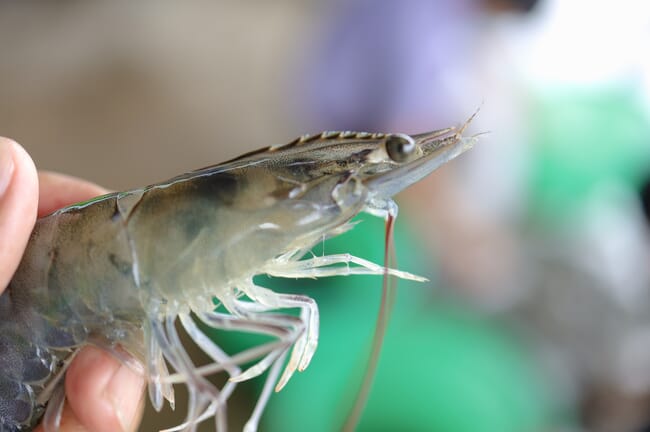
Nitrite enters across the gills of shrimp cultivated in farms and accumulates in internal tissues, resulting in physiological stress and mortality under a variety of conditions © Shutterstock
Shrimp farming
In shrimp farms, nitrite enters across the animals’ gills and accumulates in internal tissues, resulting in physiological stress and mortality under a variety of conditions. Accumulation occurs primarily in the haemolymph, intestine, hepatopancreas and gill and muscle tissues (Li et al. 2020). Under more acidic conditions, nitrite ions can form nitrous acid (HNO2), which diffuses more easily across gill membranes (Romano and Zeng 2013). Direct nitrite toxicity effects are variable and difficult to predict, but higher salinities generally result in enhanced nitrite tolerance in penaeid shrimp and other decapods. Post-larvae of Penaeus setiferus exhibited 50 percent mortality after 72 hours of exposure to 167 ppm nitrite in 25 ppt salinity (Alcaraz et al. 1999), but Valencia-Castañeda et al. (2018) found much lower nitrite tolerance in Litopenaeus vannamei post-larvae in low salinity conditions. Nitrite was more toxic than ammonia in water with salinity levels of 1 and 3 ppt, with safe nitrite levels of 0.17 ppm and 0.25 ppm respectively under these conditions.
Under more typical shrimp farming conditions (with salinity levels of > 20 ppt) nitrite levels of 2.5 to 4.5 ppm are often recorded. While some research suggests that nitrite and nitrous acid interfere with the oxygen carrying capacity of hemocyanin in certain decapods, this may not always be the case. In general, nitrite has been shown to depress immune function and increase oxidative damage in decapods, making them more susceptible to many pathogens (Romano and Zeng 2013).
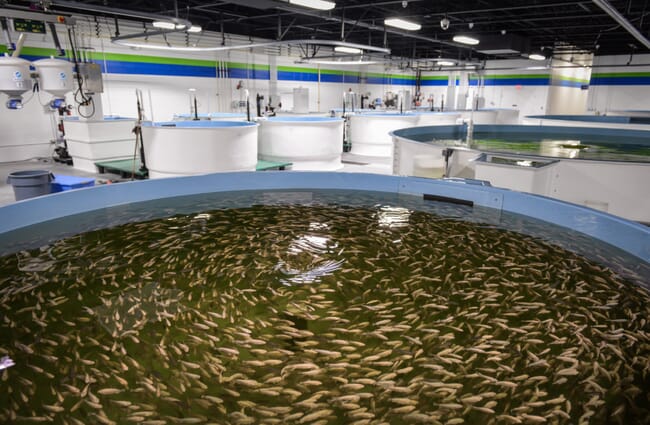
Nitrite levels in RAS depend on the performance of bacteria from both the major groups of nitrifiers – ammonia oxidisers and nitrite oxidisers
RAS
Nitrite dynamics in RAS are quite complex, so this discussion will only cover the basics. In RAS, nitrite levels depend on the performance of bacteria from both the major groups of nitrifiers (ammonia oxidisers and nitrite oxidisers). These bacteria cohabitate in (or more correctly, on) the biological filter, often along with other bacteria involved in the breakdown of wastes. When a biofilter is first established, ammonia accumulates first, then nitrites accumulate as ammonia levels begin to drop and finally levels of both compounds decline to a more or less stable equilibrium suitable for day-to-day operations. Bacterial populations exhibit slower patterns of growth and decline in coldwater RAS.
Unfortunately, in spite of decades of research and development, many RAS operators still fail to understand that without a healthy biofilter they cannot maintain healthy nitrite levels. In the early days of RAS development all one could do was simply wait for whatever bacteria were present to colonise a biofilter, but now specific bacterial strains can be seeded. Eventually, multi-functioning strains may be available, but in any case it will be difficult to exclude bacteria that find their way in on their own.
Disease management and prevention is particularly critical in RAS. Early research in the 1980s found that common disease treatments at the time often disrupted bacterial functions within RAS biofilters, leading to temporary spikes in ammonia and/or nitrite. Cupric sulphate and neomycin sulphate were especially associated with nitrite accumulation in seawater systems. Currently, very few chemotherapeutants are labelled for RAS use in most countries, so this consideration has become less of a concern as alternative disease management strategies have evolved.
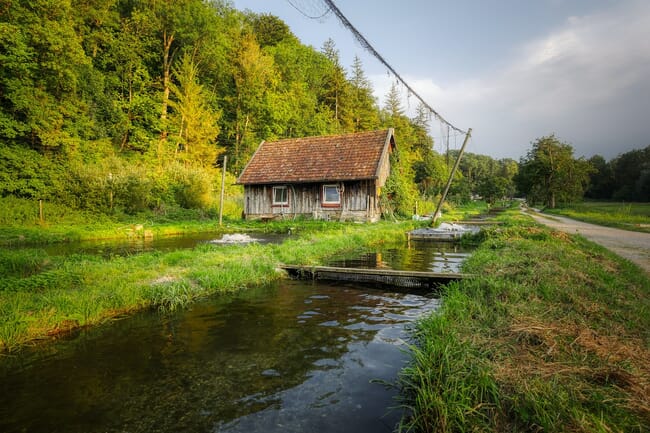
Aeration is critical in pond production if chloride levels cannot be increased through bulk additions of salt
Temperate pond production
Although methemoglobinemia can occur under a variety of conditions, in temperate climates heavy rainfall and winter feeding often contribute to conditions that lead to brown blood disease in freshwater ponds in the spring. Ammonia tends to accumulate during the winter because the water is too cold for nitrifying bacteria to function efficiently. In extreme cases high ammonia levels can contribute to seasonal disease problems like fungal infections.
Nitrite levels often increase as pond water temperatures begin to warm in the spring because the bacteria that convert ammonia into nitrite “wake up” long before those that convert the resulting nitrite into nitrate. Additionally, the nitrite-converting bacteria can sometimes be inhibited while high ammonia levels persist. As a result, until pond temperatures have risen sufficiently, nitrite levels may increase to a point where brown blood disease becomes a problem.
Catfish farmers in the southern US have found that adding salt to production ponds helps reduce brown blood disease losses. This practice is based on the strategy of adding enough chlorides to protect fish from taking too much nitrite across their gills and into their blood. Only so many ions can cross a fish’s gill surface and enter its bloodstream at any point in time, and chloride ions in solution compete with nitrite ions for the available “passages” along the gill surface. This is important because, as mentioned above, nitrite ions that enter the bloodstream bind with red blood cells and prevent them from carrying oxygen to the rest of the body. Permanently. The result is similar to gradual carbon monoxide poisoning.

Catfish farmers in the US have found that adding salt to production ponds helps reduce brown blood disease losses © Shutterstock
While adding salt to a pond seems to work well to combat nitrite poisoning, depending on local availability and pricing it can be a costly undertaking to sufficiently raise the ratio of chlorides to nitrites. Anti-caking additives must not be present in salt supplies because they can cause adverse reactions in many fish. Researchers in the southern US originally recommended a 3:1 chloride to nitrite ratio for catfish farmers, but as stocking and feeding rates increased over time the recommended ratio went up to 6:1. Further studies now suggest that a 10:1 ratio is required to sufficiently protect channel catfish and their hybrids from brown blood disease. A ratio of 16:1 completely suppresses methemoglobinemia in catfish, but the low levels of brown blood formation found at ratios of 10:1 or higher can be tolerated by healthy fish. Comparable values seem to be the rule for many other freshwater species, but researchers in Germany found that a ratio of 24:1 was required for complete protection from nitrite accumulation in the pike-perch (Sander luceoperca).
Adverse impacts from exposure to high nitrogen levels have been documented in a number of freshwater fish. Sturgeon may be particularly susceptible, as demonstrated by Matsche et al. (2012), while largemouth bass and other lepomids appear to be comparatively resistant to nitrite. Researchers at the Ontario Veterinary College reported on a springtime mortality event associated with high nitrite levels in an outdoor trout farm that recirculated water supplies in shallow ponds for subsequent re-use (Speare and Backman 1988). Although oxygen levels were normal the fish behaved as if suffering from hypoxia, and exhibited chocolate-coloured blood. Nitrite levels were measured at >0.8 ppm. Most game fish and farmed salmonids have no problem tolerating the chloride levels required to keep brown blood from occurring. In flow-through raceway facilities, however, adding sufficient amounts of salt to continuously protect against nitrite toxicity is generally not an option but, fortunately, most flow-through water sources will not present nitrite issues.
In many temperate regions (in both the Northern and Southern Hemispheres), it is not uncommon for nitrite levels to reach 10 ppm in finfish culture ponds in the springtime, so a “safe” level of chlorides to shoot for before water temperatures begin to rise would be 100 ppm. Unfortunately, nitrites can occasionally jump to levels as high as 20 ppm for the reasons described above and if this happens it may be necessary to add more salt than can be tolerated by the species in question. Other options in these instances are to keep the fish as stress-free as possible, avoid handling stress and maintain high dissolved oxygen levels (5 ppm, through aeration as needed) until nitrites eventually decline.
Seasonal advisory
Even if methemoglobinemia does not kill fish directly, it can weaken their resistance to disease, especially during the springtime when many cool- and coldwater fish species are already under stress. Over the next few months, fish producers in North America and Europe should keep in mind that their chloride levels may drop substantially from values measured in the autumn, as a result of dilution and flushing by winter rains and snow melt. To avoid being caught off guard, chloride levels should be documented now, going into the winter. Of course, this exact same advice will apply at mid-year for fish producers in the Southern Hemisphere in regions such as South America, southern Africa and Australia.
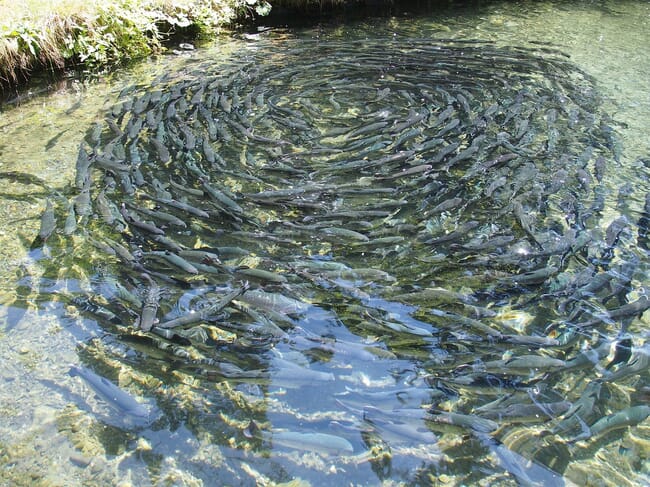
Trout can tolerate significant levels of chloride required for nitrite protection
Rock salt is often available in bulk in temperate regions, but suppliers should be identified and contacted well before deliveries may be required. It is critical to avoid bulk supplies with anti-caking or other additives. Pond and tank volumes should be accurately estimated prior to the arrival of warming temperatures, and bulk salt requirements should be calculated in ppm equivalents. Test kits for chlorides and nitrites may be hard to find locally in some regions, so now is the time to locate and purchase them.
Nitrite levels should be checked once a week from the onset of cold weather until ponds or tanks warm in the spring. Pond-based producers can avoid losses caused by nitrites through 1) diligent monitoring of water quality and feed use throughout the winter months, 2) the judicious application of chlorides, and 3) maintaining optimum dissolved oxygen levels at the first sign of methemoglobinemia.


